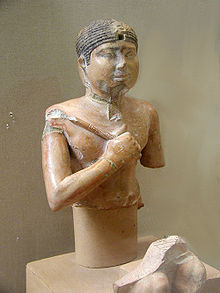- Neferefre
-
Neferefre Raneferef 
Painted limestone statue of NeferefrePharaoh of Egypt Reign 2460–2458 BC[1], 5th Dynasty Predecessor Neferirkare Kakai/Shepseskare? Successor Niuserre/Shepseskare? -
Prenomen: Isi
Jzj -


![M17 [i] i](/pictures/enwiki/50/20px-Hiero_Ca2.svg.png)

![M17 [i] i](/w/extensions/wikihiero/img/hiero_M17.png)
-
Nomen: Ra-nefer-ef
{{{1}}} -





-
Horus name: Khau-nefer
Hꜥw-nfr -




-
Nebty name: Nefer-em-nebti
Nfr-m-nb.tj -




-
Golden Horus: Nefer-bik-nebu
Nfr-bjk-nb.w -




-
Mother Queen Khentkaus II Burial Pyramid at Abusir Neferefre (also called Raneferef) was a Pharaoh of Egypt during the Fifth dynasty. His name means "Beautiful is Re" in Egyptian.[2]
Contents
Family
Neferefre was the son of king Neferirkare Kakai by queen Khentkaus II, and the elder brother of pharaoh Nyuserre Ini.
Reign
While Neferefre is given a reign of some twenty years in Manetho's Epitome, this number is a substantial overestimation of his true reign length; the current academic view is that he enjoyed a very short rule based on the completely unfinished state of his intended pyramid. A visual examination of the partly damaged data for Neferefre's reign in the Turin King List shows only a single vertical stroke for this king (each vertical stroke signifies one year). This would give him a reign of about 1 or 2 years which agrees well with the archaeological evidence. The Czech Egyptologist, Miroslav Verner, who has been excavating at Abusir since 1976, states in a 2001 journal article that:
"The shape of the tomb of Neferefra...as well as a number of other archaeological finds clearly indicate that the construction of the king's funerary monument was interrupted, owing to the unexpected early death of the king. The plan of the unfinished building had to be basically changed and a decision was taken to hastily convert the unfinished pyramid, (of which only the incomplete lowest step of the core was built), into a "square-shaped mastaba" or, more precisely, a stylized primeval hill. At the moment of the king's death neither the burial apartment was built, nor was the foundation of the mortuary temple laid."[3]
Verner concludes that based on the position of a mason's inscribed Year 1 date from Neferefre's reign which was found "on a large corner block situated at the end of the tunnel for the [pyramid's] descending corridor...at about two thirds of the height of the extant core of the monument", Neferefre reign lasted "not longer than about two years."[4]
The only known date from his reign is the aforementioned mason's inscription from his first Year in the foundation of his pyramid tomb. Little else is known about Neferefre. While the name of Neferefre's undiscovered sun temple is known to be Hetep-Re[5], no such structure has yet been discovered owing perhaps to the short length of his reign.
A significant cache of administrative papyri–comparable in size to the Abusir Papyri found in the temple of Neferirkare–was discovered at Abusir by a 1982 University of Prague Egyptological Institute excavation from a storeroom of his mortuary temple.[6]
Likewise, it is not known whom he succeeded and by whom he was in turn succeeded as pharaoh. Generally, his predecessor is held to be Shepseskare, an even less-known king, and Neferefre's successor is often believed to be his younger brother Niuserre. But Shepseskare apparently ruled for a few weeks only - he is not mentioned in Khau-Ptah's list of the kings he served under -, and seals bearing his horus name were found in the oldest part of Neferere's mortuary temple - which, as noted above, was not started until after Neferere was already dead. Consequently, Shepseskare might have ruled either before or after Neferefre, perhaps signifying a dynastic conflict between the lineages of Neferirkare Kakai (to which Neferefre and Niuserre belonged) and Sahure (of whom Shepseskare might have been a son).
Pyramid complex
Because of the premature death of Neferefre, his successor hastily completed work on Neferefre's pyramid at Abusir, which acquired the form of a mastaba. Although it may share the same resemblance to a mastaba tomb, it is not situated north-south, and it is not rectangular in shape, but square on all sides. Known as the "Unfinished Pyramid", it stands just seven meters high, but from the constructed portions, the walls slope at a 64º angle. Similarly to other sites of other Ancient Egyptian pyramids, the burial site of Neferefre contains more than one pyramid, and his lines up the three pyramids, similarly to the Great Pyramids. Artifacts found at the site show that the name of his pyramid was called "Divine is Neferefre's Power." All the other buildings of Neferefre's mortuary complex were erected under the reign of his brother, Nyuserre Ini. While exploring ruins of the mortuary complex, a Czech archaeological expedition discovered papyri of temple accounts, statues of the king, decorated plates and many seal prints. Pieces of mummy wrappings and bones were also found, which were discovered to be the remains of Neferefre. An anthropological analysis of his mummy reveals the king to have died in his early twenties, at between 20 and 23 years old.[7] This evidence accords well for a king who died relatively soon into his reign and left an unfinished tomb.
See also
- List of Egyptian pyramids
- List of megalithic sites
References
- ^ Shaw, Ian, ed (2000). The Oxford History of Ancient Egypt. Oxford University Press. p. 480. ISBN 0-19-815034-2.
- ^ Peter Clayton, Chronicle of the Pharaohs, Thames and Hudson, paperback, 2006. p.61
- ^ Miroslav Verner, Archaeological Remarks on the 4th and 5th Dynasty Chronology, Archiv Orientální, Volume 69: 2001, p.400
- ^ Verner, p.400
- ^ Neferefre by J. Dunn
- ^ Nicolas Grimal, A History of Ancient Egypt, (Blackwell Books: 1992), p.77
- ^ Verner, p.401
External links
Categories:- Unfinished buildings and structures
- Pharaohs of the Fifth dynasty of Egypt
- Fifth dynasty of Egypt
-
Wikimedia Foundation. 2010.
